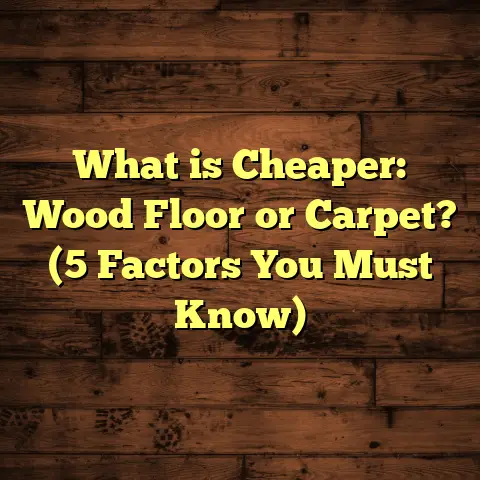What is Reclaimed Wood Flooring? (5 Benefits You Should Know)
Wood flooring has been gaining more attention lately, especially among homeowners who want something authentic and sustainable in their homes. I’ve noticed a steady rise in interest for materials that tell a story, and reclaimed wood flooring fits that desire perfectly. If you’ve ever been curious about what reclaimed wood flooring really is, or why so many people are turning to it, I’m here to share everything I’ve learned from years of working with it. Let’s talk about what reclaimed wood flooring is and why it might just be the perfect choice for your next project.
What Is Reclaimed Wood Flooring?
Reclaimed wood flooring is exactly what it sounds like: wood that’s been taken from old buildings, barns, factories, or other structures that are being demolished or renovated—and then repurposed as flooring. Instead of cutting down new trees, this wood gets a second chance to shine in a new space.
This process involves salvaging the wood, carefully cleaning it, removing any nails or other metal objects, milling it to the right thickness, and then finishing it to match the desired look and durability standards. The result is a floor that carries the character and history of its previous life but is fully functional and durable for modern use.
When I first started using reclaimed wood in my projects, I was blown away by how much personality it added to a room. It’s not just about being eco-friendly; it’s about having floors with stories etched into every knot and scratch.
Why People Are Choosing Reclaimed Wood Flooring
Let’s think about why reclaimed wood flooring is becoming such a popular choice. For one, there’s a growing awareness about environmental issues and the need to reduce waste. Plus, reclaimed wood offers a unique look—something you can’t get with new lumber.
Plus, many of the old trees used in reclaimed wood came from forests that grew slowly over many decades or even centuries. That means the wood tends to be denser and harder than most new wood grown today, which often comes from faster-growing plantations.
According to data from the Hardwood Federation and various industry sources, sales of reclaimed wood flooring have increased by roughly 30% over the past five years. This highlights how sustainable design choices are becoming more mainstream.
1. Environmental Impact: A Sustainable Flooring Solution
One of the biggest benefits of reclaimed wood flooring is its positive impact on the environment. By reusing old wood, you’re helping keep trees standing and reducing landfill waste.
The construction industry generates millions of tons of waste annually—much of it includes discarded wood. Salvaging this material for new floors helps reduce this waste. For example, the U.S. Environmental Protection Agency estimates that construction and demolition debris make up nearly 600 million tons per year in the U.S., and a significant portion of that is wood.
From my experience working on green building projects, homeowners often choose reclaimed wood flooring because they want to minimize their ecological footprint. One client I worked with was passionate about sustainability; we sourced reclaimed oak from a nearby old factory slated for demolition. Not only did they love the look, but they also felt great knowing they were saving resources.
Here’s a quick breakdown to consider:
| Environmental Benefit | Impact |
|---|---|
| Trees saved | Hundreds (per 1,000 sq ft floor) |
| Landfill waste reduced | Tons (per project) |
| Energy saved vs new lumber | Up to 50% less energy |
| Carbon emissions avoided | Significant reduction |
Reclaimed wood flooring also requires less processing energy compared to freshly milled hardwood. This means fewer carbon emissions from manufacturing.
2. Unique Character That You Can’t Get with New Wood
Something I always emphasize to clients is that reclaimed wood floors come with a one-of-a-kind character. You’ll find imperfections like nail holes, saw marks, weathering patterns, or even faded paint remnants that tell a story.
I remember installing reclaimed heart pine flooring in a client’s renovated barn-turned-home. The boards showed decades of wear and weathering from their previous life on the farm. This authentic patina gave the room warmth and personality that no new floor could replicate—even high-end engineered hardwood couldn’t match it.
Many clients tell me they appreciate how these imperfections add charm instead of detracting from the floor’s beauty.
Each plank has its own story, making every floor unique. This uniqueness can’t be duplicated with synthetic distressing or new wood treatments without looking artificial.
3. Durability From Old-Growth Timber
Another big advantage is the strength of reclaimed wood. The trees used for older lumber grew slowly over many years — sometimes over 100 years or more — resulting in tighter grain and denser wood.
A good example is heart pine reclaimed from old barns: It has a Janka hardness rating of about 1,690 lbf, compared to red oak’s 1,290 lbf, which is one of the most popular species for new hardwood floors today. This means reclaimed heart pine resists dents and scratches better than many new woods.
I’ve seen reclaimed floors last well beyond 100 years when properly maintained. That durability means fewer repairs and less replacement over time, making it a smart investment even if it costs more upfront.
Here are some hardness ratings for common reclaimed species compared to commonly used new hardwoods:
| Species | Janka Hardness Rating (lbf) |
|---|---|
| Reclaimed Heart Pine | 1,690 |
| Reclaimed White Oak | 1,360 |
| New Red Oak | 1,290 |
| New Maple | 1,450 |
This data shows why reclaimed wood floors tend to stand up very well over time.
4. Cost Considerations: Is Reclaimed Wood Flooring Worth It?
You might wonder if reclaimed wood flooring is more expensive than new options—and it can be initially. The extra labor needed to remove nails, prep the boards, and sometimes repair damaged sections adds cost.
However, when you factor in durability and lifespan, the cost tends to even out. A typical reclaimed wood floor might cost between $8 to $15 per square foot installed depending on species and quality. New hardwood floors often range from $6 to $12 per square foot installed but may not last as long without damage.
I’ve had clients tell me they valued reclaimed flooring as an investment in their home’s future value because it adds character that buyers love—especially in historic or custom homes.
Here’s a rough cost comparison per square foot (installed):
| Flooring Type | Cost Range (USD) |
|---|---|
| Reclaimed Wood | $8 – $15 |
| New Hardwood | $6 – $12 |
| Laminate | $2 – $5 |
| Vinyl Plank | $3 – $7 |
While laminate or vinyl may be cheaper upfront, they don’t offer the same longevity or appeal as real reclaimed wood.
5. Design Flexibility: Fits Many Styles
You might think reclaimed wood only works in rustic or farmhouse settings—but that’s not true at all. With different finishes and species available, it can fit modern, industrial, traditional, or eclectic designs.
For example, I recently worked on a city loft where the reclaimed flooring was finished with a low-gloss gray stain that complemented sleek metal furniture perfectly while still adding warmth underfoot.
Reclaimed planks come in various widths—from narrow strips to wide planks—and can be finished smooth or rough-hewn depending on your style preference.
This flexibility makes reclaimed wood suitable for:
- Contemporary urban apartments
- Cozy country cottages
- Industrial-style offices
- Traditional family homes
Personal Stories From My Experience
Early in my career, I worked on a project where the client wanted something unique for their downtown loft but wasn’t sure about reclaimed wood. After seeing samples salvaged from old warehouses nearby, they were sold on the idea.
The installation took longer because we had to carefully remove old nails and prepare each plank but the final floor was stunning. Months later, the client told me how impressed their guests were with the floor’s character — it really made their home stand out.
On another job renovating an old barn into a family home, we reused much of the original flooring combined with additional salvaged white oak planks from local sources. The client loved that their floors carried history from the very building they were living in—a connection you just don’t get with new materials.
What To Expect During Installation
Reclaimed wood flooring installation isn’t quite like new hardwood. Each plank needs careful inspection to remove metal objects like nails or screws that can damage tools or cause injury.
Moisture content must be checked carefully since older wood can behave differently once inside your home environment. Proper acclimation—allowing the boards to adjust indoors before installation—is essential to prevent problems like warping or gaps later on.
I always recommend hiring installers with experience handling reclaimed materials because mistakes can get costly if boards aren’t properly prepared or installed.
Installation Tips I Share With Clients
- Allow at least 5-7 days for acclimation indoors.
- Inspect each board for hidden nails or staples.
- Choose finishes that highlight character without hiding natural imperfections.
- Use underlayment suitable for your subfloor type.
- Plan for slight color variation—this is part of the charm!
Common Questions I Get Asked About Reclaimed Wood Flooring
Q: Can reclaimed wood have pests or mold?
A: Properly sourced and treated reclaimed wood should be free of pests. Treatment processes include kiln drying and chemical treatments that eliminate mold or insects.
Q: How do I maintain reclaimed wood floors?
A: Maintenance is similar to other hardwood floors—regular sweeping or vacuuming plus occasional cleaning with manufacturer-recommended products. Avoid excessive moisture.
Q: Is it safe for indoor air quality?
A: Yes! Most reputable suppliers use low-VOC finishes and ensure boards are clean and dry before installation. This helps keep indoor air healthy.
Q: Can I install reclaimed wood over radiant heating?
A: Yes, but you’ll want to check moisture content carefully and use appropriate installation techniques recommended for radiant heat systems.
Real Case Study: Barn Renovation Using Reclaimed Wood Flooring
Here’s a detailed look at one project where we converted an old barn into a modern family home using reclaimed wood floors sourced both from the barn itself and local salvage yards:
- Project Size: 1,200 sq ft
- Wood Species: Heart pine & white oak
- Installation Time: 3 weeks
- Waste Factor: ~10% (due to damaged or unusable boards)
- Cost: $12-$15 per sq ft (materials + installation)
- Finish: Low-VOC matte polyurethane
The results were fantastic—the floors retained original nail holes and weathered patina while meeting all modern durability standards. The client reported improved indoor air quality thanks to careful finishing choices.
Long-Term Care Tips From My Experience
To keep your reclaimed wood floor looking great for decades:
- Use rugs in high-traffic areas.
- Clean spills immediately.
- Avoid harsh chemical cleaners.
- Refinish every 7-10 years depending on wear.
- Maintain consistent indoor humidity (ideally 35%-55%).
Final Thoughts on Reclaimed Wood Flooring
If you want floors that bring warmth, history, and sustainability into your home, reclaimed wood flooring merits serious thought. It offers unmatched character combined with durability from centuries-old trees.
Have you ever walked across a floor that seemed alive with stories? That’s what reclaimed wood brings—an authentic connection to both nature and history beneath your feet.
If you’re curious about sourcing quality materials or want advice on installation and care, just ask—I’m happy to share what I’ve learned through years of hands-on experience.





